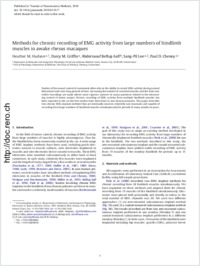Methods for chronic recording of EMG activity from large numbers of hindlimb muscles in awake rhesus macaques
- Hudson, Heather M. Department of Molecular and Integrative Physiology, University of Kansas Medical Center, Kansas City, USA
- Griffin, Darcy M. Department of Molecular and Integrative Physiology, University of Kansas Medical Center, Kansas City, USA
- Belhaj-Saïf, Abderraouf Unit of Physiology, Department of Medicine, University of Fribourg, Switzerland
- Lee, Sang-Pil Department of Molecular and Integrative Physiology, University of Kansas Medical Center, Kansas City, USA
- Cheney, Paul D. Department of Molecular and Integrative Physiology, University of Kansas Medical Center, Kansas City, USA
-
25.04.2010
Published in:
- Journal of Neuroscience Methods. - 2010, vol. 189, no. 2, p. 153-161
English
Studies of the neural control of movement often rely on the ability to record EMG activity during natural behavioral tasks over long periods of time. Increasing the number of recorded muscles and the time over which recordings are made allows more rigorous answers to many questions related to the descending control of motor output. Chronic recording of EMG activity from multiple hindlimb muscles has been reported in the cat but few studies have been done in non-human primates. This paper describes two chronic EMG implant methods that are minimally invasive, relatively non-traumatic and capable of recording from large numbers of hindlimb muscles simultaneously for periods of many months to years.
- Faculty
- Faculté des sciences et de médecine
- Department
- Département de Médecine
- Language
-
- English
- Classification
- Biological sciences
- License
- License undefined
- Identifiers
-
- RERO DOC 18126
- DOI 10.1016/j.jneumeth.2010.03.011
- Persistent URL
- https://folia.unifr.ch/unifr/documents/301670
Statistics
Document views: 68
File downloads:
- bel_mcr.pdf: 177
